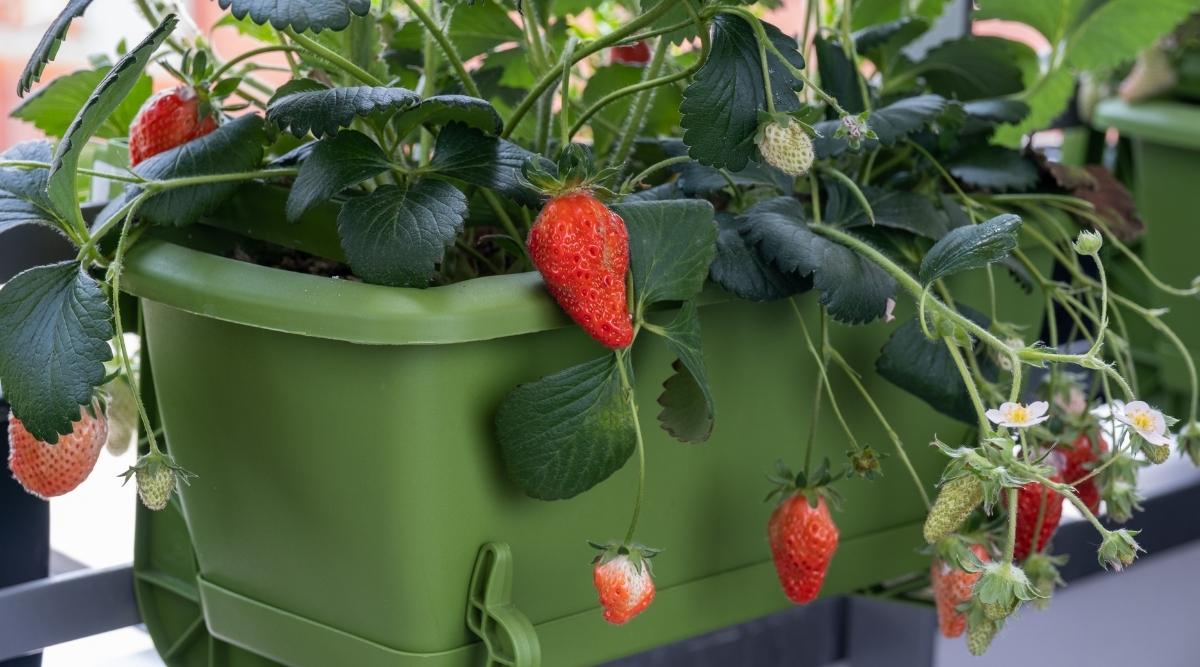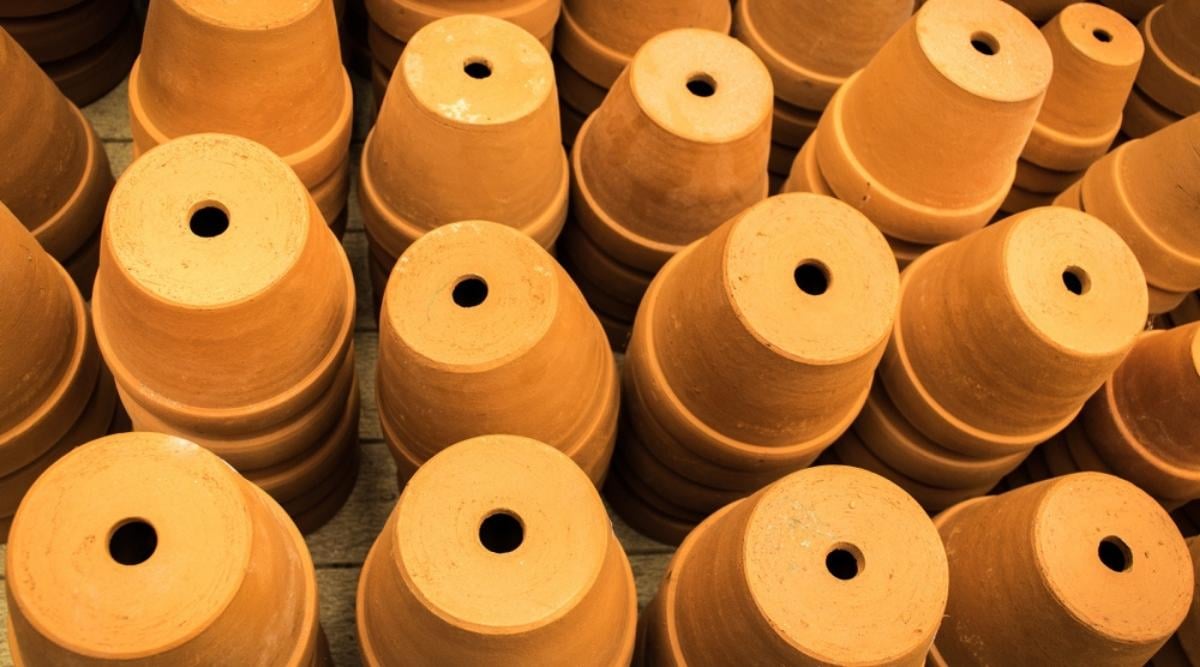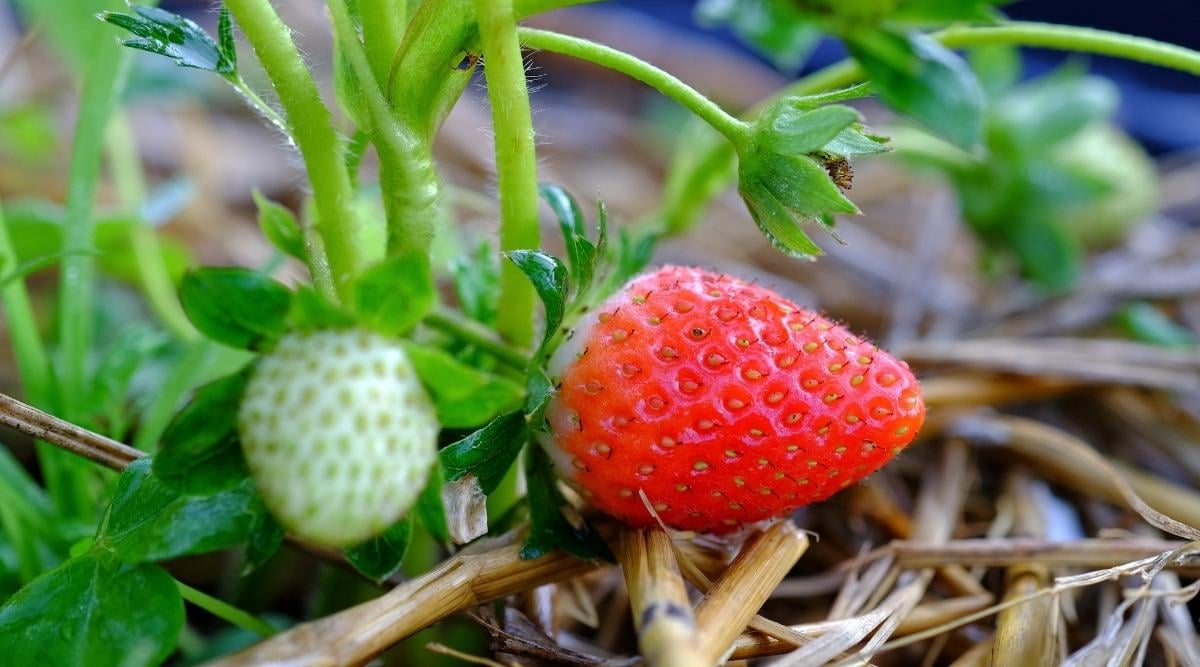15 Tips For Growing Strawberries in Pots or Containers
Thinking of planting some strawberries in pots or containers this gardening season? Strawberries can indeed be planted in pots or containers, but getting them to produce a great fruit crop will take a little bit more art than science. In this article, organic gardening expert Logan Hailey walks through her favorite tips on growing strawberries in containers or pots!

Contents
Few things can compare to a flavorful, fresh, juicy strawberry grown straight from your own garden. But if you don’t have a yard or community garden plot, you may feel like you’re missing out on these infamous summer jewels.
Fortunately, strawberries are some of the easiest fruits to grow in containers. Modern breeding efforts have created compact varieties that are specially suited for pots or hanging baskets. And you may be shocked by just how many berries can grow from a small container.
Whether you have a container garden, a south-facing patio, or hanging baskets on your balcony, you can grow strawberries that are just as fruitful as regular garden beds. The secrets lie in choosing the right strawberry, the right pot, the best potting mix, and simple care practices. Let’s dig into our top 17 tips for growing an abundance of strawberries in containers.
Choose the Right Variety
The perfect container strawberry garden starts with the right cultivar. If you don’t pick the right type of strawberry, you may end up with a crowded planter or a tangled mess that produces a bunch of runners instead of berries.
Choose Compact Varieties

Some strawberries are natural roamers that want to create big mats of groundcover. Others are bred to be a bit more tame and compact so that they grow as small bushes. Depending on your pruning methods, compact strawberry plants can spread up to 6-12” in size and about 8” tall.
Compact strawberry varieties may still produce runners (the little suckers that shoot out to grow new plants), but are easier to control.
Our favorite compact strawberries for containers include:
- ‘Seascape’
- ‘Albion’
- ‘Yellow Wonder’
- ‘Ozark Beauty’
- ‘For Laramie’
- ‘Quinault’
Ever-Bearing or Day Neutral Cultivars

Generally, ever-bearing varieties tend to be the most reliable container producers. These varieties are compact in size, produce the fewest runners, and yield 2-3 consistent flushes throughout summer and fall.
If you want to pick ripe berries off of your strawberry containers throughout the season, day-neutral cultivars are also prized for hanging baskets and pots because of their abundant yields that keep on coming all summer long.
Both ever-bearing and day-neutral cultivars will readily produce fruit regardless of the day length. They are the highest yielding types that tend to flower and fruit reliably so your containers stay full of juicy berries throughout the season.
As a rule of thumb, it’s best to avoid traditional June-bearing types in container gardens. They take one year to mature (start growing fruit), produce lots of runners, and only provide one big flush at a time (great for canning, but not for snacking). June-bearers also need more pruning and tend to get tangled inside of containers.
Use Nursery Starts

While bare root strawberries give you the most bang for your buck, nursery starts tend to be the best for beginner container gardens. This is because 1) bare root strawberry crowns often come in larger quantity bundles and 2) they require a bit more planting knowledge.
For the quickest, easiest start to establishing your strawberry planters, choose nursery starts that are ready to transplant. Similar to the garden veggie 6-pack starts you may be used to, these plugs will already have established root balls and lush growing foliage. They are easier to handle and don’t require as much precision as planting bare root crowns.
This is a super straightforward process that is very similar to planting vegetable seedlings. You can learn more about transplanting strawberries in this guide.
Choose The Right Pot

When it comes to their container preferences, strawberries are pretty laid back. You can select from a wide range of window boxes, terracotta pots, grow bags, and other types of planters to grow abundant berries on your patio or balcony.
Strawberries have fairly shallow root zones, but they don’t want to be so vertically restricted that they can’t dig deep enough to hold the plant upright. Shallow roots mean more likelihood of falling over and out of the pot in the event of high winds, heavy watering, or even heavy fruit sets.
Whether they’re growing in containers or in the ground, strawberries tend to grow roots about 6 inches to 1 foot into the soil. Deeper roots mean more physical anchoring and a greater resilience to drought or nutrient stress.
This is why it’s best to pick a container that is a minimum of 6-8” deep, but ideally 10-12” in depth for a flourishing root zone.
Keep Berries Away From Soil

We all love chocolate-covered strawberries, but we’d prefer our strawberries aren’t covered in soil. Certain containers are designed to keep strawberries dangling in the air or off the side of the pot rather than sitting on top of the soil.
When you select a container, keep in mind which direction the berries will be growing. A few great options include:
Stackable Vertical Garden Pots
These indoor or outdoor planters include 5 tiers of anchored plastic pots that provide a full 360° view of several strawberry plants. They are specifically designed to keep berries dangling off the sides for a gorgeous display. The stackable design saves space and maximizes yields for small spaces.
Strawberry Grow Bags
If you want something that is lightweight and easy to maneuver, a fabric grow bag is a cheap, portable container for growing strawberries. They include side pockets where berries can burst out, as well as breathable fabric that keeps the strawberry roots extra happy.
Terracotta Pots
Classic terracotta containers with water catchment trays are also great for strawberries. Just be sure you grow only 1-2 plants per pot.
Window Box
Strawberries will gladly grow in the classic rectangular planters as well. You can usually get 2-3 plants into one window box. If you are growing indoors, they will need the sunniest south-facing window you can find.
Ceramic Pots
If you have some nice painted ceramic pots laying around, try planting some berries in them! Ideally, you can use ceramics that are about 8-10” deep and 6-10” in diameter. Make sure you have a drainage tray underneath!
Hanging Baskets
My personal favorite way to grow strawberries is in hanging baskets. These coir-lined wire baskets are supportive and large enough for 1-2 bushy strawberry plants. They allow berries to hang out in every direction and create a beautiful accessory that is both ornamental and edible.
Ensure Your Pot Has Drainage Holes

Strawberries hate sitting in soggy or waterlogged soil. In a regular garden, water can pass through the soil profile or raised bed and keep on draining. But in a container, strawberries are more prone to root rot from moisture-loving pathogens.
It’s important to choose a container that allows for ample drainage when watering. Ideally, there are several drainage holes where moisture can flow out so that there is never any pooling of water at the bottom of the pot.
Most pots come with drainage holes already drilled and a saucer or water catchment tray to sit underneath. For outdoor planters and hanging baskets, you can simply let water drip onto the ground below.
Use a Well-Draining Potting Mix

Like we mentioned above, drainage is key for successfully growing strawberries in pots. Ensure that your potting mix allows water to move through the root zone without pooling up or getting stagnant.
You can test the drainage of your soil by filling a container with it and then pouring water over the top to measure the water infiltration capacity. If it goes into the potting mix very quickly, you are good to go for planting strawberries.
However, if it creates a little pond of water on the surface, this is a sign that you either compacted the soil too hard into the pot or your mix is not well-drained enough.
The best ingredients for ensuring drainage in strawberry pots include:
- Peat moss
- Perlite
- Vermiculite
- Shredded bark
- Coco coir
- Compost
- Decomposed manure
- Chipped leaf litter
- Sand
Pay Attention to Soil Ingredients

Container soil is important because your berries can’t access all the nutrients and microbes they’d usually have when growing in the ground. Strawberries prefer a rich potting mix that will retain moisture, drain quickly, and provide ample micronutrients.
A loamy soil is one that has an equal combination of sand, silt, and clay, as well as a high volume of organic matter. Organic matter is just biodegraded natural materials that are full of nutrients and microbes to support healthy strawberries growing in pots.
The organic matter in a container mix can come from:
- Compost
- Worm castings
- Peat moss
- Coco coir
- Decomposed manure
- Rotted leaves
- Humus
- Bat guano
- Aged forest products
Whichever mix you choose, just be sure that your strawberries will have at least one or more of these sources of quality organic matter.
Ensure Your Soil Has Proper pH

Strawberries like a slightly acidic soil with a pH between 5.5 and 7.0.
You can achieve this by mixing in small amounts of sawdust, coffee grounds, or pine needles. Or to make things simpler, you can also select an “acid loving plant” mix such as those made for roses and azaleas.
Give Your Strawberries Space

Overcrowding is a key reason for low strawberry yields. Just like people uncomfortably packed into a subway and dying to get out, strawberries prefer some personal space.
Pots and containers are a restricted area that work perfectly for compact strawberry plants as long as they don’t get too crowded. When you’re first transplanting strawberries into a pot, it may seem like you can squeeze several small plants into the container. Try to resist this urge and keep strawberries spaced 6-8” apart. For most planters, this means one plant per pot.
When strawberries are overcrowded they may appear lush and green but they won’t have much energy to put into growing flowers and fruit. If you want to harvest berries instead of just growing leaves, give each strawberry plant at least 6-8” of space on all sides.
Prune Off All Runners

Runners are the bane of any strawberry growers existence, but they’re especially problematic for container growers. These long stems are what strawberries use to spread their population and clone themselves in the wild. They are sometimes called “suckers” because they “suck” the mother plant’s energy out to create new baby plants.
For high yielding container strawberries, it is absolutely essential to prune off all the runners, whether you are planting your strawberries in raised beds, containers, or pots. While they may look nice cascading from a hanging basket, they will slowly drain the productive capacity of your strawberry plant by channeling its energy into growing new baby plants rather than growing berries.
Pruning runners is as easy as cutting off the “stolons” as soon as you notice them emerging from the center of the plant. The sooner you catch them, the better. However, it won’t hurt if you forget to cut them off by the time a new baby plant is growing at the end. Better late than never!
Remember, you don’t want more greenery and you definitely don’t want overcrowded strawberries. Train your plants to put their energy into fruiting by snipping off every sucker you see.
Give Them Adequate Sun

Although wild strawberries thrive in the shady understory of temperate forests, cultivated strawberries do best in full sunlight. Place your strawberry pots in an area that gets at least 8 hours of direct sunlight per day.
The area can be an exposed patio, a balcony, or porch that doesn’t get too shady in the afternoon. Placing potted strawberries on an outdoor table or hanging from a hook on the corner of a veranda can help keep them elevated and closer to that summer sunshine they crave.
This is also important because bees and pollinators will be able to access your strawberries in these sunny locations. While many strawberries are self-pollinating or wind-pollinated, bee pollination can significantly boost berry yields.
Growing strawberries indoors isn’t recommended unless you have an open greenhouse.
Keep Containers Consistently Moist

Consistent moisture is the key to an abundance of juicy, plump strawberries. Containers dry out much more quickly than regular garden beds. This is because there’s less volume of soil and more heat on the container (which dries out the root zone).
It’s important to strike a balance between overwatering and underwatering. Ideally, you should check strawberry pots every 1-3 days by sticking your finger 3-6” into the container. If it comes out with lots of soil caked on, your plant likely has plenty of water. If it comes out clean and dry, your strawberries are probably thirsty.
Overwatering and underwatering often have the same symptoms in potted strawberries: the leaves will appear wilted and unhappy, and the plant may stop producing flowers and fruit. You have to check the soil to make sure it isn’t over-saturated nor bone dry. Find a happy medium by watering small amounts every other day and regularly doing the finger test.
Provide a Nice Dose of Nutrients

Container strawberries are a bit more finicky about fertilizer than their soil-grown counterparts. Providing a gentle dose of diluted kelp solution at the time of planting is a great way to start the season off right.
Then, you can fertilize every 2 weeks until they start flowering. Amend with a well-balanced granulated organic fertilizer or water with diluted liquid fish fertilizer. Be careful not to over-fertilize with nitrogen, as this can create a greater flush of leaves instead of the coveted fruits.
If you plan to overwinter your strawberries, you can give them a nice dose of compost before they go into dormancy. This will help the roots further establish in the container before the next spring.
Harvest Regularly

Perhaps it should go without saying, but you shouldn’t wait to pick your ripe berries! Those vibrant juicy fruits are ready to be eaten as soon as they have turned a deep crimson red.
If you want container strawberries to continue yielding, you need to harvest the ripe ones as they appear. This will promote more flower production, which means more fruit in the coming weeks!
Once ever-bearing and day-neutral varieties start fruiting in the late spring or early summer, you can expect consistent strawberry harvests 2-3 times per week as long as your containers have ample moisture and sunlight.
Did you know that strawberries maintain the best flavor when they aren’t refrigerated? When berries are ripe and red, use your fingers or snips to cut dangling berries from the plant. Enjoy right away or store them in a cool, dark part of the kitchen counter.
Overwinter Strawberries Indoors

In cold climates, overwintering potted strawberry plants and hanging baskets is super easy.
Around the time of the first fall frost, you’ll notice your plants begin to shrivel and wither. Don’t panic! This is simply a sign of the strawberry going into dormancy.
Once the green leaves have died back, you can add a little layer of straw or dried leaf mulch to the top of the container.
You don’t want to keep the strawberries excessively warm or you may trigger them to break dormancy. At the same time, you don’t want the soil to totally freeze inside the pots.
The best winter storage options are usually an unheated garage, potting shed, or a root cellar. Gardeners in extra cold zones (5 and colder) may want to wrap their containers in bubble wrap or foil insulation to prevent them from freezing and cracking.
Because they are naturally dormant in the winter, there is no use in bringing strawberries indoors unless you have grow lights to trick the plant to keep fruiting.
Growers in warm climates may be able to get away with harvesting strawberries almost year round. Otherwise, you can allow your potted plants to stay outside and rest during the cooler months and watch them revitalize in the spring.
Grow Container Strawberries Indoors

Strawberries are technically perennial plants, but even commercial farmers often grow them as annuals just like lettuce or tomatoes. If you don’t want to deal with overwintering your berries, growing potted strawberries as annuals is the easiest choice.
Simply toss your old strawberry plants in the compost pile in the fall and buy new day-neutral starts in the spring to get a fresh start. Keep in mind that this method only works with day-neutral varieties because they will fruit in the same year as they are planted.
Final Thoughts
Thankfully, you don’t need a huge garden to enjoy luscious red berries all summer long. Growing strawberries in pots or containers is simple and beginner-friendly as long as you follow these key tips:
- Choose compact varieties
- Check that you have ever-bearing or day-neutral types
- Use nursery starts
- Choose a container that’s at least 6-8” deep
- Get a pot that keeps berries off the soil surface
- Make sure there are drainage holes
- Use quality, well-drained potting mix
- Check that soil mix ingredients include organic matter
- Ensure a slightly acidic pH
- Don’t let strawberries get overcrowded
- Prune off all the runners
- Place pots in full sunlight where bees can find them
- Keep containers consistently moist
- Provide all-purpose organic fertilizer every 2 weeks until fruiting
- Harvest strawberries as they ripen
- Overwinter in a garage
- Grow potted strawberries as annuals
If you follow these steps, you will be well ahead of your crop when planting strawberries this season, and you’ll be likely to have a bountiful harvest from your strawberries in pots!










